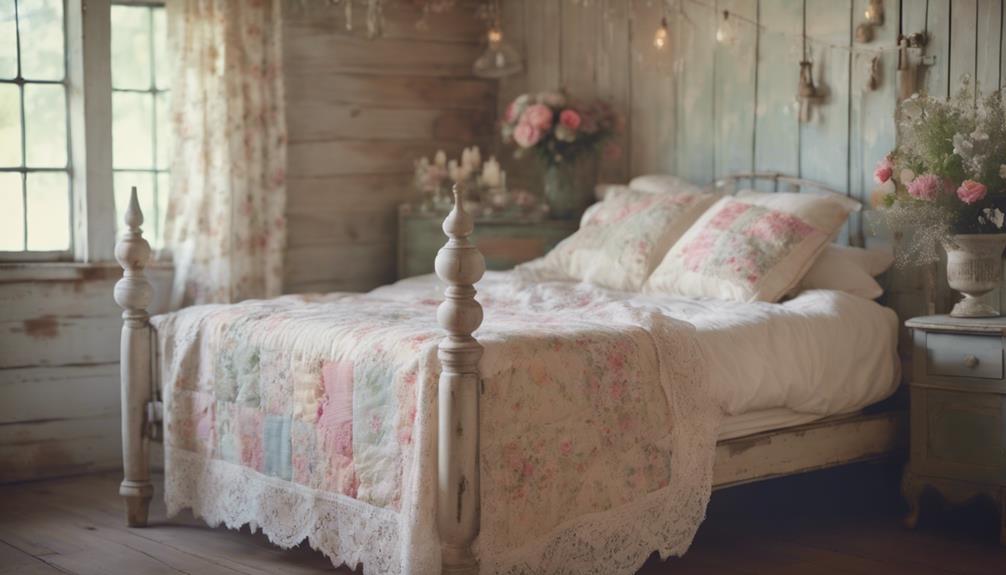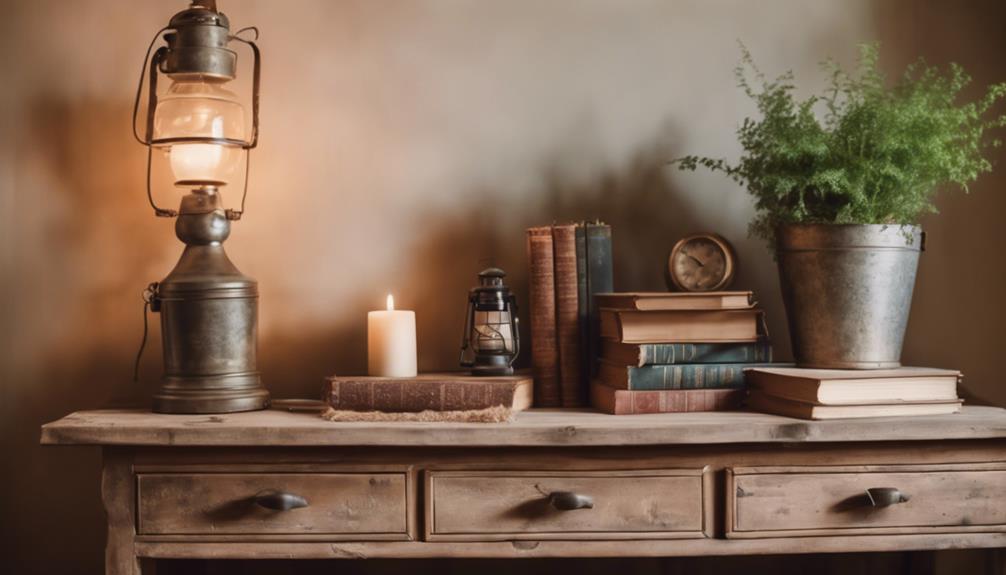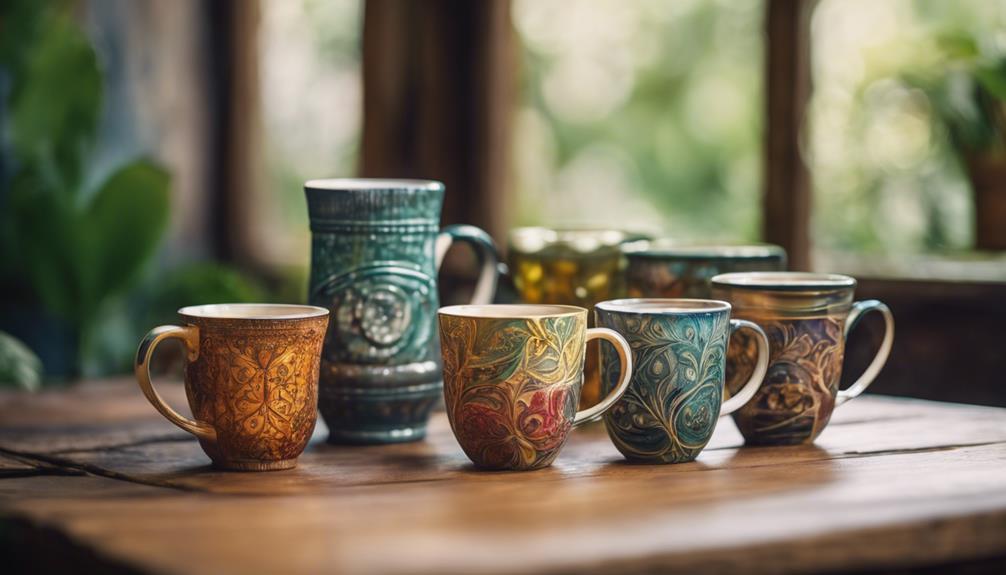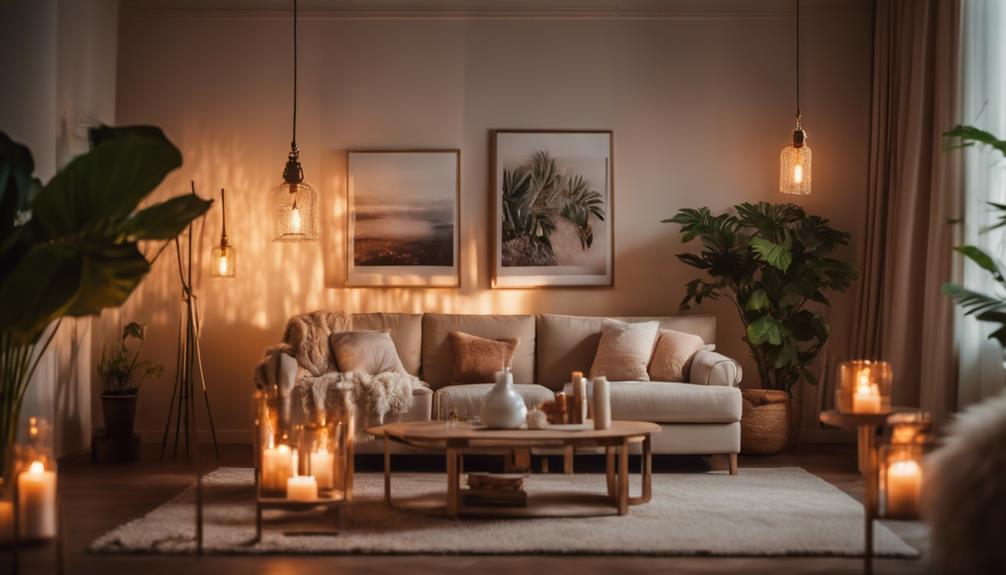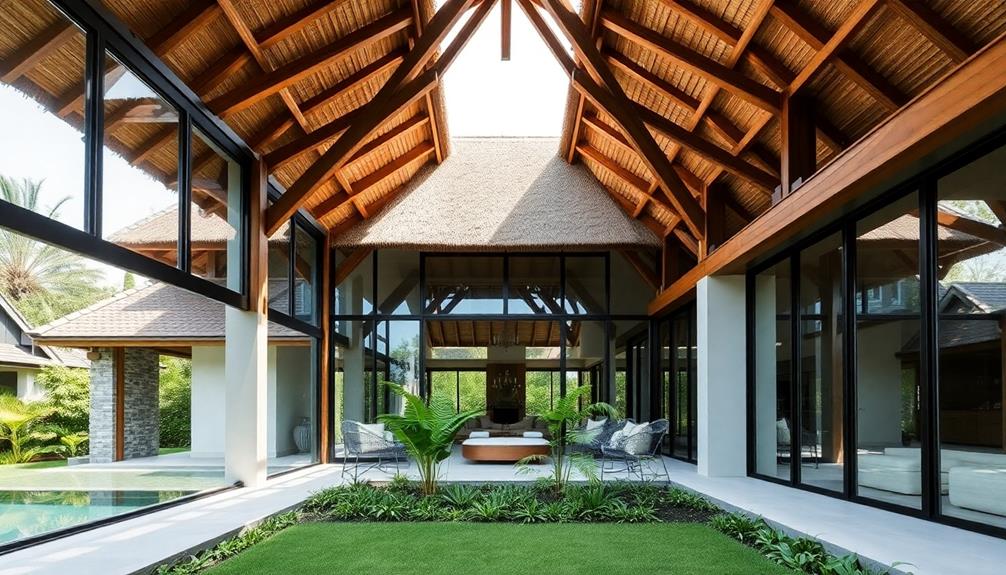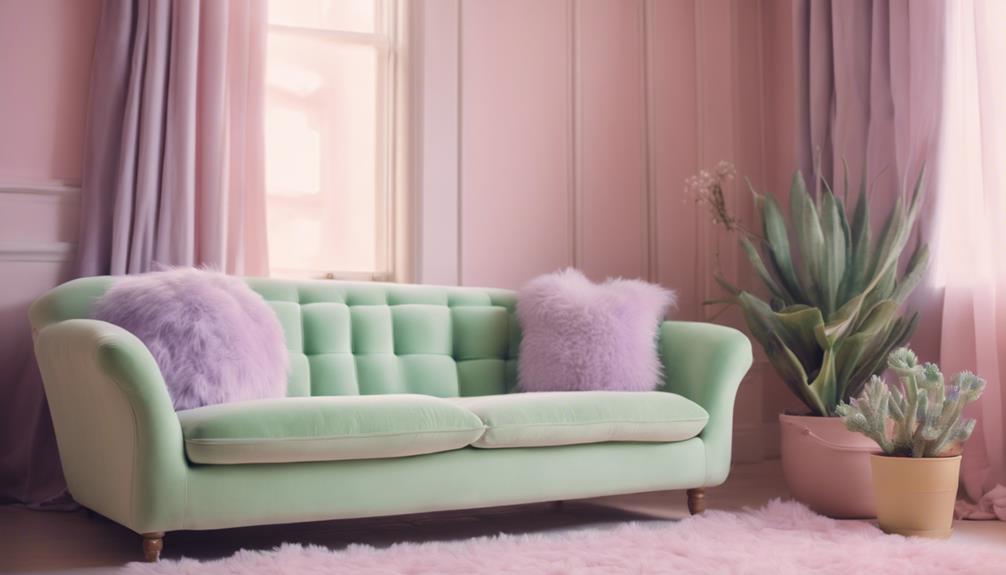Transform your bedroom into a dreamy haven with shabby chic touches that blend vintage charm and modern comfort. Use soft pastels like pink and lavender to create a calming atmosphere, and consider a vintage wrought iron bed frame as a charming focal point. Add cozy accent pieces like button-tufted benches and decorative baskets for warmth. Soft, romantic lighting from vintage lamps and crystal chandeliers enhances the cozy vibe. Incorporate floral patterns in your wall decor and bedding to promote relaxation. By exploring more, you'll uncover additional tips to create your perfect retreat for sweet dreams.
Key Takeaways
- Incorporate soft pastel color palettes with floral patterns for a calming and cozy atmosphere ideal for restful sleep.
- Choose vintage-inspired bed frames, such as wrought iron or tufted headboards, to create a dreamy focal point in your bedroom.
- Utilize romantic lighting options, like crystal chandeliers and vintage lamps, to enhance the warm ambiance and invite relaxation.
- Decorate with vintage wall art and mirrors to add character and reflect light, creating an inviting and spacious feel.
- Layer soft area rugs and natural fiber options to provide comfort underfoot and complement the shabby chic aesthetic.
Overview of Shabby Chic Style
Shabby Chic style blends vintage charm with modern comfort, creating a cozy and inviting atmosphere in your bedroom. This design approach draws inspiration from French Country aesthetics, emphasizing a romantic vibe that feels both nostalgic and welcoming.
In a romantic Shabby Chic bedroom, you'll find furniture that showcases elegant wear and tear, adding character and warmth to the space. Key elements include wrought iron bed frames, canopy beds, and tufted headboards that elevate your comfort while exuding timeless elegance.
You can enhance the overall aesthetic by incorporating vintage wall decor and soft textiles, such as lace curtains and plush throws. Floral patterns are also a staple, often appearing on bedding or wall art to reinforce that cozy, romantic feel.
When you adopt shabby chic style, you create an environment that encourages relaxation and intimacy. Imagine curling up with a good book or enjoying a peaceful night's sleep in a room that feels like a charming European cottage.
With its perfect blend of old and new, shabby chic transforms your bedroom into a sanctuary that feels both stylish and inviting.
Essential Color Palettes
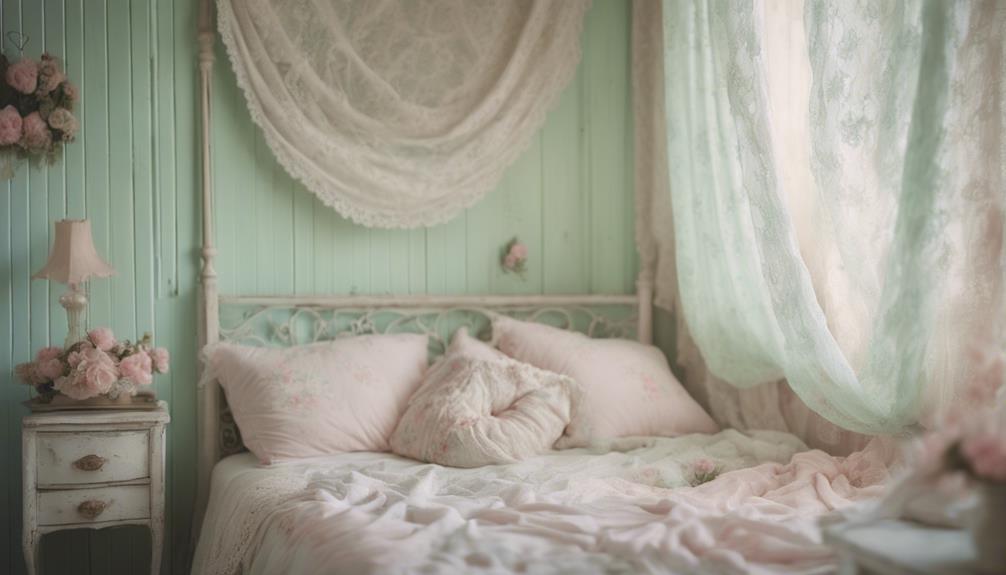
When choosing colors for your shabby chic bedroom, consider soft pastels like pink, green, and lavender to create a calming atmosphere.
You can also mix in moodier tones like warm grey or dusky mauve for a more personalized touch.
Layering these shades will enhance the overall design, making your space feel both inviting and stylish.
Pastel Color Combinations
Pastel color combinations are essential for creating a soothing and romantic atmosphere in your shabby chic bedroom. These pastel color palettes, featuring soft shades like blush pink, mint green, and lavender, help promote relaxation and serenity.
To enhance this airy feel, pair your chosen pastels with neutrals such as creamy whites and light grays. This will create a cohesive design throughout your space.
Incorporating floral patterns within these pastel color schemes can add depth and texture to your decor. For instance, consider a floral-printed duvet cover in soft yellows and blues, which will harmonize beautifully with your pastel hues.
Layering pastel tones can also create visual interest; try combining a pastel blue bedspread with pale yellow throw pillows for a comforting yet stylish look.
One of the best aspects of using pastel color combinations is their flexibility. You can easily integrate your favorite hues while still adhering to the shabby chic aesthetic.
Whether you prefer a monochromatic approach or a mix of various pastels, you'll find that these combinations create a dreamy environment that invites relaxation and rest.
Moodier Tones Integration
Integrating moodier tones like warm greys and dusky mauves can elevate your shabby chic bedroom, adding sophistication while still maintaining a cozy atmosphere. These deeper shades move beyond the traditional pastel palette, enhancing the romantic vibe that shabby chic designs are known for.
By choosing moodier tones, you create a calming environment, perfect for a restful retreat. Layering soft textures, such as plush throws and delicate floral patterns, with these colors adds visual interest, blending elegance with comfort seamlessly. This approach allows you to express your unique style while adhering to the shabby chic aesthetic.
Don't shy away from mixing and matching these moodier tones with lighter elements. For instance, pairing a dusky mauve accent wall with soft white bedding can create a stunning contrast that feels both inviting and chic. The flexibility in color choices enables you to curate a space that reflects your taste, making your bedroom a true sanctuary.
Ultimately, integrating moodier tones into your shabby chic designs not only enriches the visual depth but also fosters an atmosphere that encourages relaxation and sweet dreams. So, go ahead and experiment with these shades to transform your space!
Key Furniture Pieces
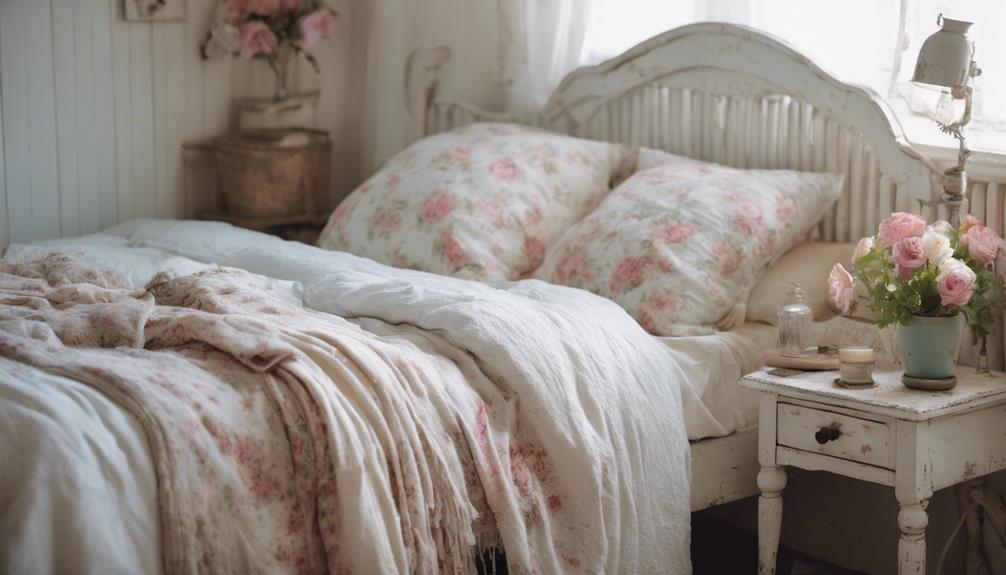
When it comes to your shabby chic bedroom, choosing the right furniture pieces is essential.
Opt for vintage-inspired bed frames and elegant nightstands to set the tone, while cozy accent furniture adds warmth and charm.
These selections not only enhance the overall aesthetic but also create a welcoming and stylish retreat.
Vintage-Inspired Bed Frames
Vintage-inspired bed frames are essential for creating a shabby chic bedroom that exudes charm and elegance, seamlessly blending comfort with a touch of nostalgia. When selecting the perfect frame, consider styles that highlight vintage furniture elements, such as wrought iron or canopy beds.
Here's a quick guide to help you visualize your options:
| Bed Frame Type | Features | Aesthetic Appeal |
|---|---|---|
| Wrought Iron Bed | Delicate designs, cottage appeal | Vintage charm |
| Canopy Bed | Luxurious feel, cozy ambiance | Romantic elegance |
| Tufted Headboard Bed | Button-tufted, classy comfort | Timeless sophistication |
Incorporating a button-tufted headboard adds both comfort and elegance, enhancing your shabby chic aesthetic. These frames not only serve as the focal point of your bedroom but also reflect a nostalgic vibe that invites relaxation. With the right vintage-inspired bed frame, you'll create a dreamy retreat that's perfect for restful nights and sweet dreams. Don't overlook this key furniture piece, as it sets the tone for your entire space!
Elegant Nightstands Selection
Elegant nightstands play an essential role in enhancing the shabby chic aesthetic, offering both style and functionality to your bedroom retreat. You'll want to look for elegant nightstands that feature soft silhouettes and distressed finishes, as these elements create that romantic ambiance you're aiming for. Materials like wood with a whitewashed or pastel finish resonate beautifully with the airy feel of shabby chic design.
Consider nightstands that incorporate practical details such as drawers or shelves. This combination of functionality and charm helps keep your space organized while maintaining the enchanting look. Don't forget to add personal touches—floral or ruffled elements, like decorative trays or unique lampshades, can introduce texture and further complement your theme of nostalgia.
To achieve a cohesive look, select nightstands that harmonize with other furniture pieces in your bedroom, such as a tufted headboard or a vintage dresser. When you choose the right elegant nightstands, you'll not only enhance the beauty of your space but also create a serene environment perfect for sweet dreams.
Cozy Accent Furniture Choices
Adding cozy accent furniture pieces can transform your shabby chic bedroom into a warm and inviting retreat. Start with a wrought iron bed frame; its charming cottage appeal sets a perfect foundation for a cozy atmosphere. If you prefer something more elegant, consider a canopy bed that adds a dreamy vibe to your space.
To enhance comfort, a button-tufted headboard not only serves as a luxurious focal point but also brings softness to the room. Complement this with classic chests featuring curved silhouettes. They offer functional storage solutions while adding height and visual interest to your decor.
For side tables, opt for gold and glass options. They contribute an airy feel to the space, maintaining a light and elegant look that aligns with the shabby chic style. Finally, a tufted bench can serve multiple purposes; it provides additional seating and is a perfect spot for laying out clothing and accessories.
Each of these accent furniture choices works together to create a cozy atmosphere, making your bedroom a serene space where you can unwind and enjoy sweet dreams.
Romantic Lighting Choices
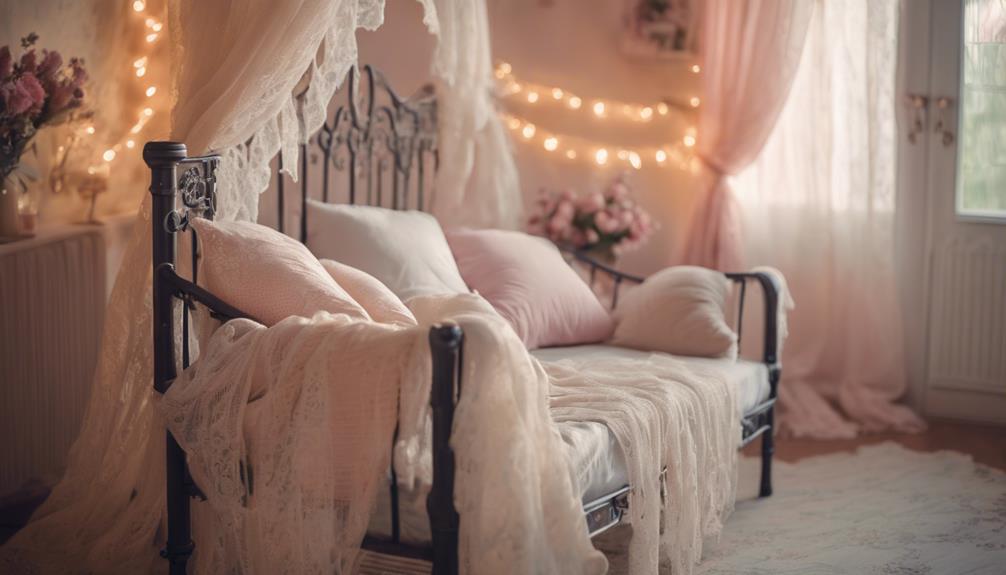
Romantic lighting choices can transform your shabby chic bedroom into a cozy retreat, where soft glows and sparkling accents create an inviting atmosphere.
Start by adding a stunning crystal chandelier, which serves as a beautiful focal point that contrasts with your rustic furniture. This elegant touch not only brightens the space but also enhances its romantic vibe.
Vintage lamps with ruffled lampshades are another fantastic addition, providing soft, diffused lighting that fosters a warm ambiance.
To take it a step further, consider installing dimmers on your light fixtures. This allows you to adjust brightness to suit your mood, whether you're winding down with a book or hosting a romantic evening.
Don't forget the role of natural light! Sheer curtains can filter sunlight gently, adding a lightness that complements your shabby chic aesthetic.
Layering various light sources, like fairy lights or candles, creates a magical, intimate setting perfect for relaxation.
When you embrace these romantic lighting choices, you'll not only enhance your bedroom's charm but also create a space that invites sweet dreams and tranquility.
Vintage Wall Decor Ideas
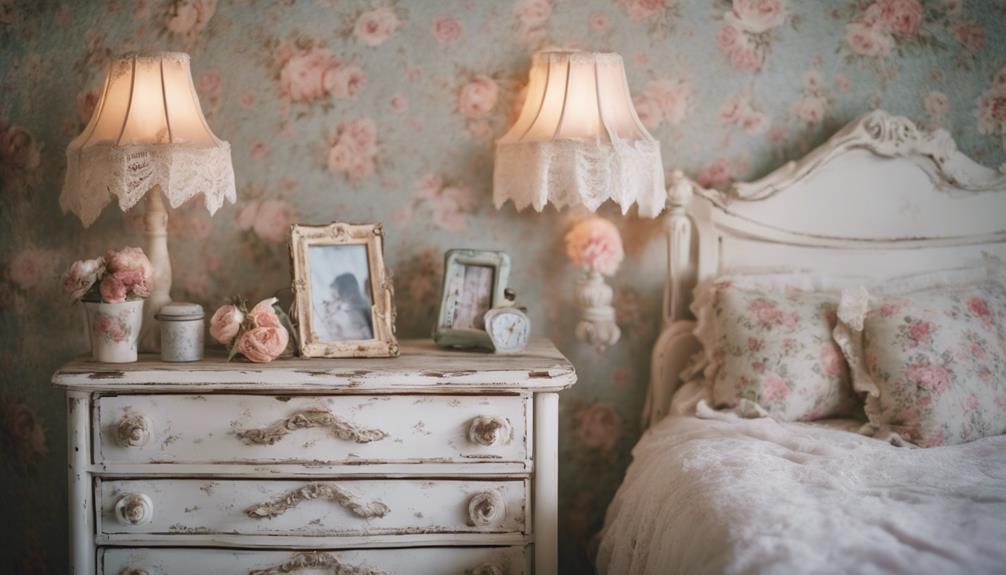
To enhance the cozy charm of your shabby chic bedroom, vintage wall decor ideas can infuse personality and character into the space. Consider incorporating pressed flower wall art, which brings a touch of nature indoors while also creating a nostalgic ambiance. The unique designs of vintage frames can elevate your wall art, making each piece a statement that reflects your style.
Another option is to use wallpaper with pastel floral patterns. This not only serves as a focal point but also enriches the room with color and character. If you want to create a sense of openness, decorative wall mirrors with ornate, hand-dressed frames are perfect. They reflect light beautifully, enhancing the overall ambiance of your bedroom.
Don't shy away from DIY projects, either. A gallery wall featuring vintage photos and artwork allows you to showcase your individual creativity while maintaining that shabby chic aesthetic. By mixing and matching different vintage elements, you can create a warm, inviting space that feels uniquely yours.
Embrace these vintage wall decor ideas, and watch your bedroom transform into a dreamy retreat.
Incorporating Floral Patterns
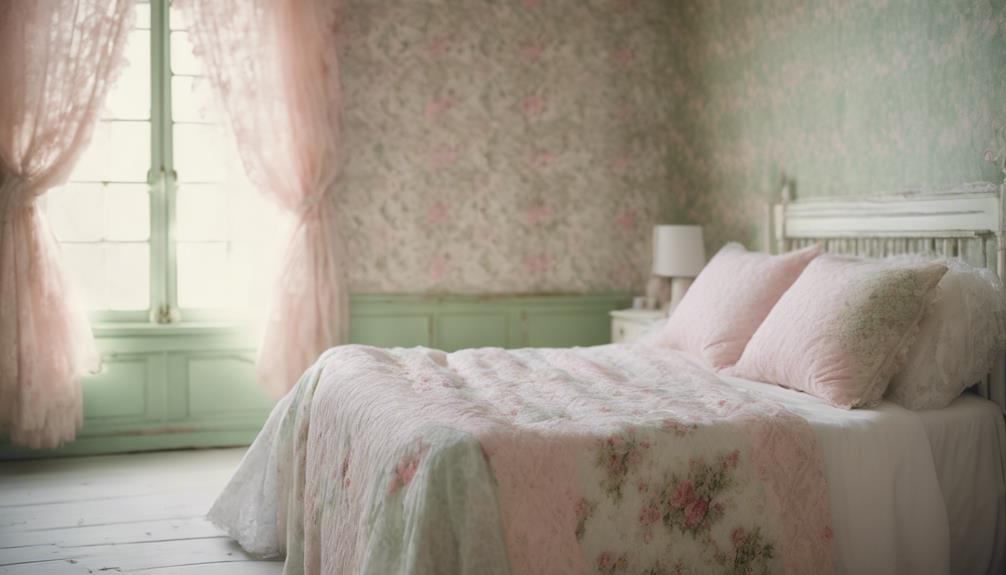
Incorporating vibrant floral patterns throughout your shabby chic bedroom instantly creates a warm and inviting atmosphere that feels both cozy and stylish. Floral patterns are a hallmark of shabby chic decor, often showcased in bedspreads, throw pillows, and curtains. These prints evoke natural beauty and enhance the romantic aesthetic of your space.
You can opt for bold, colorful florals to make a statement or choose subtle designs for a more minimalist approach. Delicate embroidery or small-scale patterns provide an elegant touch while maintaining the shabby chic vibe.
Layering floral textures, such as ruffled bedding or cushioned floral chairs, adds depth and comfort, promoting a relaxing environment perfect for unwinding.
Don't forget that floral motifs aren't just visually appealing; they also contribute to a calming ambiance essential for achieving sweet dreams in your shabby chic bedroom.
Cozy Flooring Solutions
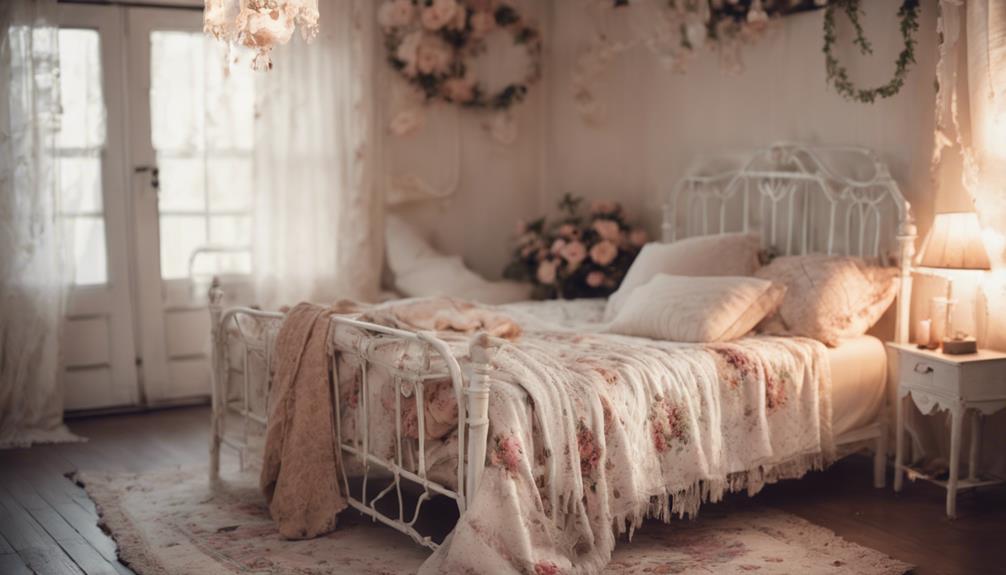
Cozy flooring solutions can greatly enhance the warmth and inviting feel of your shabby chic bedroom. By choosing the right materials, you'll create a space that feels both comfortable and stylish. Soft rugs, especially plush area rugs or vintage Persian styles, offer a comforting touch underfoot, while layering rugs can add texture and visual interest.
Here's a quick overview of some ideal flooring options:
| Flooring Type | Benefits |
|---|---|
| Soft Rugs | Adds warmth and comfort |
| Distressed Wood | Complements shabby chic style |
| Natural Fibers | Introduces organic, rustic charm |
Light-colored carpets can promote an airy atmosphere, while natural fibers like jute or sisal align perfectly with the shabby chic look. These materials harmonize beautifully with your pastel and neutral color palette, reinforcing a cohesive and calming environment.
Ultimately, selecting cozy flooring solutions is essential for creating a dreamy bedroom oasis where you can unwind and relax. Invest in flooring that enhances the overall aesthetic and comfort, ensuring your bedroom remains a haven of tranquility.
DIY Wall Treatments
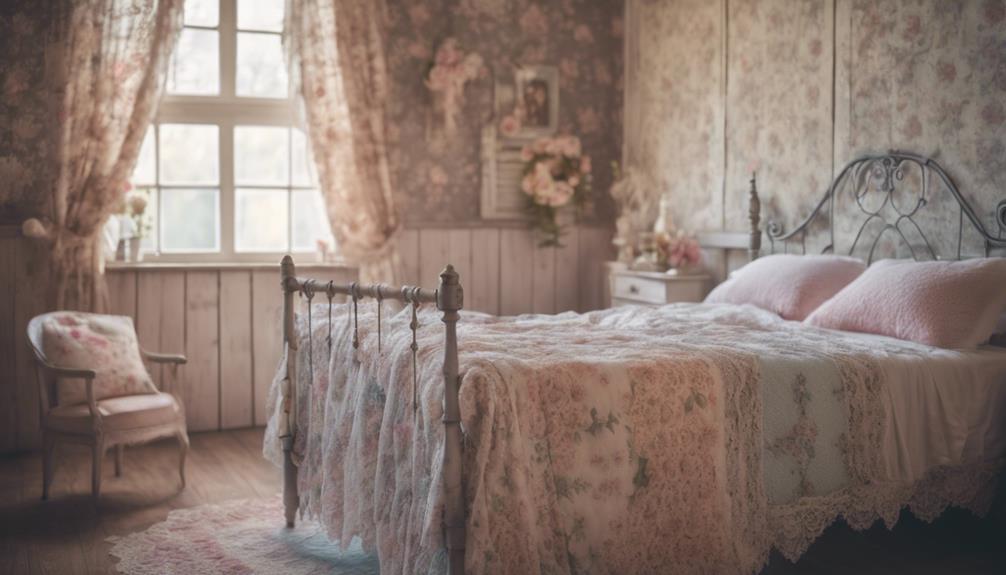
When you think about DIY wall treatments for your shabby chic bedroom, floral wallpaper can instantly add a touch of whimsy and romance.
You can also explore upcycled decor techniques, like using vintage frames or reclaimed wood, to create unique accents that showcase your personal style.
Let's explore how these elements can transform your space.
Floral Wallpaper Inspiration
Floral wallpaper instantly transforms your shabby chic bedroom into a romantic retreat, infusing it with charm and nostalgia. Choosing pastel floral patterns—like soft pinks and lavenders—aligns perfectly with the traditional shabby chic color palette, creating a calming environment. If you're feeling adventurous, try moodier floral designs with dusky mauve or warm grey backgrounds for a unique twist that still feels cohesive.
DIY wall treatments let you release your creativity. You could go for removable wallpaper, which makes it easy to change up your look without a long-term commitment. Alternatively, stenciling floral designs directly onto your walls offers a personal touch and keeps costs down.
To enhance the floral wallpaper's visual impact, layer it with vintage frames or mirrors. This not only adds depth but also creates a visually engaging space that embodies the shabby chic aesthetic. Your walls can tell a story, reflecting your personal style while keeping that romantic vibe intact.
With floral wallpaper, you'll create a dreamy sanctuary that invites relaxation and sweet dreams. Embrace this timeless trend, and watch your bedroom blossom into a serene escape.
Upcycled Decor Techniques
Upcycled decor techniques breathe new life into old furniture and materials, allowing you to craft unique wall treatments that perfectly embody the shabby chic style. One of the easiest ways to incorporate upcycled decor is by using vintage wallpaper scraps or fabric remnants. You can create a stunning patchwork accent wall that reflects your personal style while enhancing the romantic ambiance of your bedroom.
Additionally, consider using distressing techniques on old wooden panels. A simple sanding or applying a paint wash can yield a rustic backdrop that complements the shabby chic aesthetic beautifully. DIY projects like framed fabric panels or repurposed window shutters also serve as charming wall decor, combining functionality with vintage flair.
Incorporating natural elements, such as reclaimed wood or driftwood, into your wall treatments adds a cozy, cottage-like atmosphere essential to shabby chic design. With these techniques, you'll not only beautify your space but also promote sustainability, making your bedroom a true reflection of your values and style.
Embrace upcycled decor, and watch as your shabby chic bedroom transforms into a dreamy retreat.
Outdoor-inspired Elements
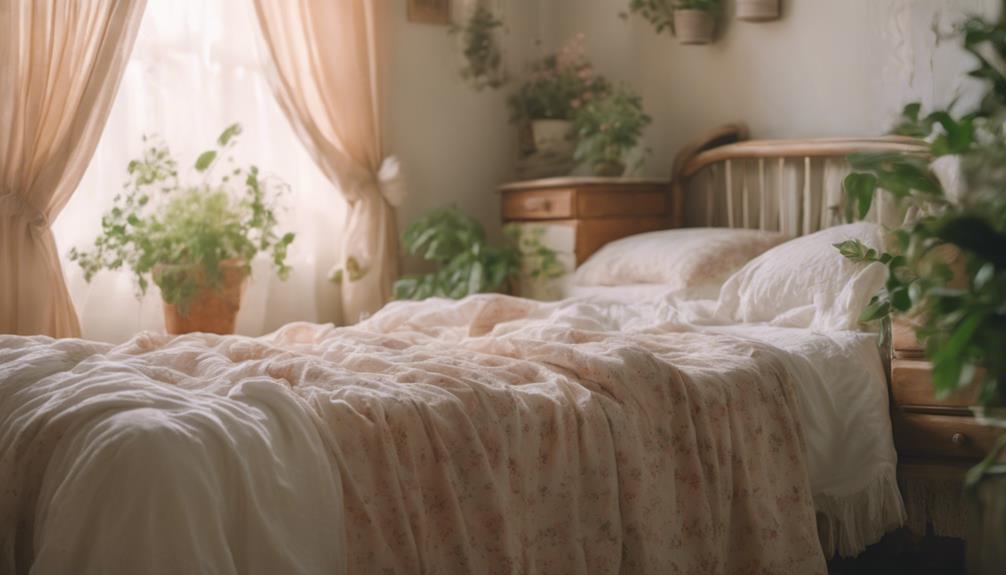
Bring the beauty of nature indoors by incorporating outdoor-inspired elements into your shabby chic bedroom. Start by adding potted plants and fresh flowers to instantly connect your space with the outdoors. These natural accents not only enhance your home decor but also promote tranquility, making your bedroom a serene retreat.
Consider using outdoor-inspired motifs, like botanical prints and garden-themed accessories, to infuse a revitalizing vibe into your decor. Sheer curtains are another great choice, allowing natural light to filter through while creating an airy atmosphere reminiscent of a sunlit garden.
Don't forget to incorporate wicker furniture or rattan accents; these elements evoke rustic charm and further tie your indoor space to a garden-like ambiance. Layering textiles with floral patterns and nature-inspired colors can enrich the shabby chic aesthetic, giving your bedroom a cozy, inviting feel that resembles an outdoor escape.
Functional Space Design
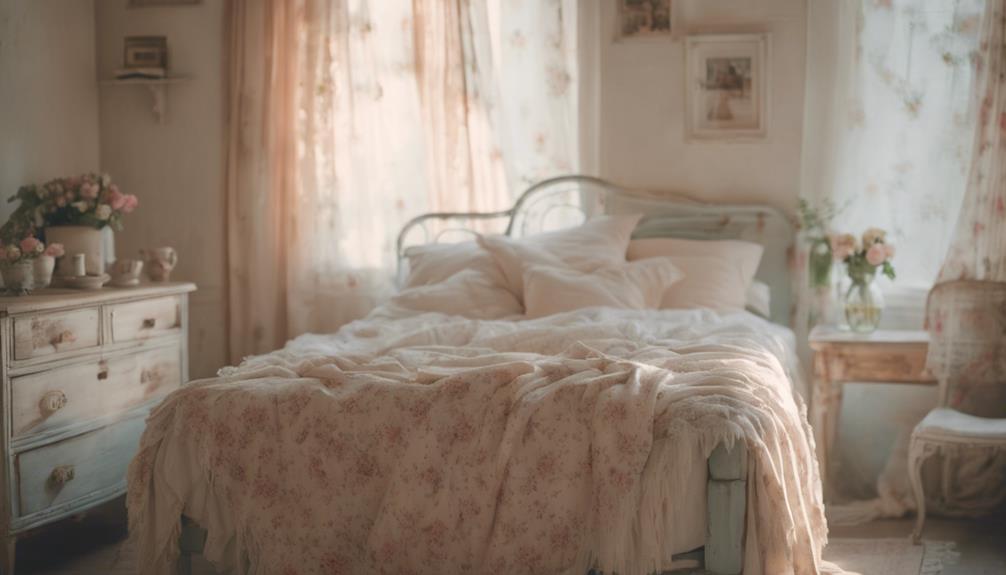
To create a functional shabby chic bedroom, you can seamlessly blend style and practicality by incorporating multi-purpose furniture and smart storage solutions. This approach not only enhances your space but also keeps it organized and inviting.
Consider these ideas for effective functional space design:
- Ottomans with storage: They serve as both a seating option and a place to stash extra blankets or pillows.
- Beds with built-in drawers: Maximize your bedroom's storage potential while maintaining the vintage charm.
- Decorative baskets and vintage trunks: Use them to organize items discreetly, adding character to your decor.
- Layered rugs: These not only add texture but also help define areas like a cozy reading nook or a workspace.
Conclusion
Incorporating shabby chic elements into your bedroom can truly create a dreamy retreat.
By blending soft colors, vintage furniture, and cozy decor, you're bound to feel right at home.
Don't forget to add your personal touch with DIY projects and outdoor-inspired accents.
With these ideas in hand, you'll be well on your way to a space that's both functional and inviting.
So, go ahead and make your bedroom a haven where you can truly let your hair down!
